electric car
-
Tesla Model S review: Still the king of the hill?
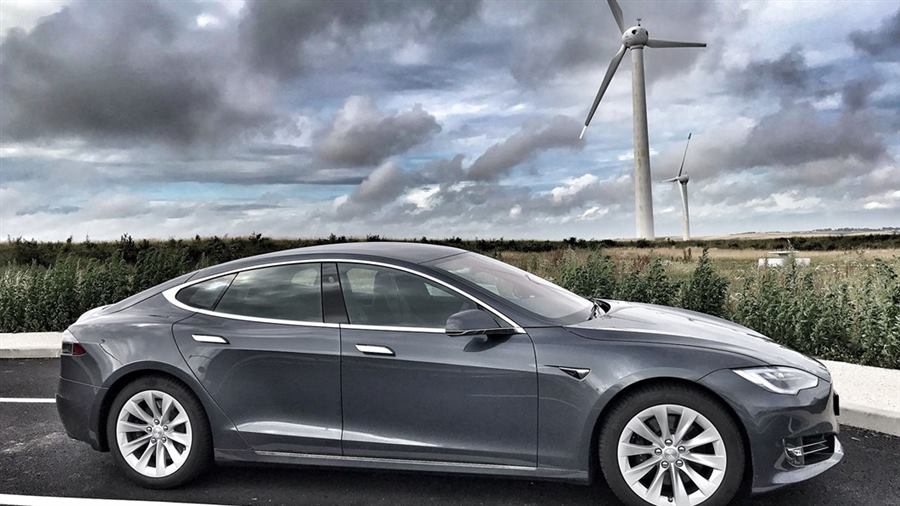
Such is the pace of change in Silicon Valley that it’s hard to keep up with the Tesla Model S. Not just in a straight line (the Long Range Plus hits 155mph after getting to 60mph in 3.7 seconds) and in the fast-changing electronics and user interfaces onboard (now updated every few months, wirelessly) - but also in the evolution of the model range itself.
Since its latest model update in 2019, there have been just two versions of the Tesla Model S range: Long Range Plus and Performance. Battery variations are no longer signified by the numbers as they used to be, and Tesla no longer quotes the battery capacity of its models anymore. Is it being coy? Of course not – just simplifying the customer journey for its iconic old stager EV.
Old stager? Yes! The Model S has been around in its basic form since 2014, and although it has been constantly updated, this elegant-looking five-door fastback is under increasing attack from the established premium players. But while they're launching their first offerings, Tesla's groundbreaking technology has evolved significantly. Closest in concept is the Porsche Taycan, which in entry-level 4S form comes very close to matching the Model S Long Range Plus in terms of power, performance and price.
Tesla Model S: What's under the skin?
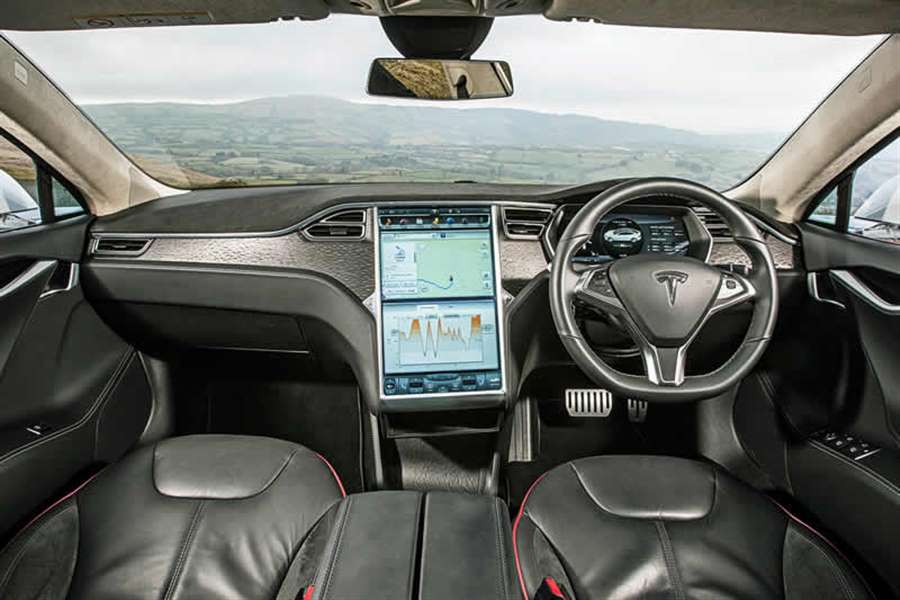
It’s a big car, at almost 5m long, 1963mm wide and 1435mm tall. No wonder there’s huge space front and back; just watch out for pinched headroom in the rear seats if you spec the sweeping panoramic sunroof. With no propshaft required, there is a totally flat floor though. The boot's a good size, although the 'frunk' under the bonnet is surprisingly smaller than a 911's. Open the large tailgate and you’ll find a 774-litre boot which can be extended by folding the back seats to reveal a cavernous 1645-litre capacity.
The cabin is incredibly spacious with a flat floor allowing easy and comfortable access to the middle seat in the rear. The light and airy interior is dominated by that huge 17.0-inch portrait-model infotainment screen which controls almost all of the Model S’s infotainment and ancillary features like climate control, seat heating and driving modes. Because the screen is so large and its operating system is so simple to use, this is one touchscreen that doesn't annoy.
For those who have yet to experience the Tesla Supercharger network, it's simplicity itself. You can charge it by three-pin plug (but who would?) or by Type 2, which typically gets you 23 to 68 miles of range per hour. But it's Supercharging that's Tesla's USP, and it's a joy to use, especially as it's free for life for Model S owners. And now with V3 Supercharging, which reduces charging times by an average of 50%. Tesla claims the new high-speed ultra-rapid chargers could add as much range as 1000 miles per hour.
This is still the only EV capable of trans-continental travel without serious prior planning.
Tesla Model S: How fast is it?
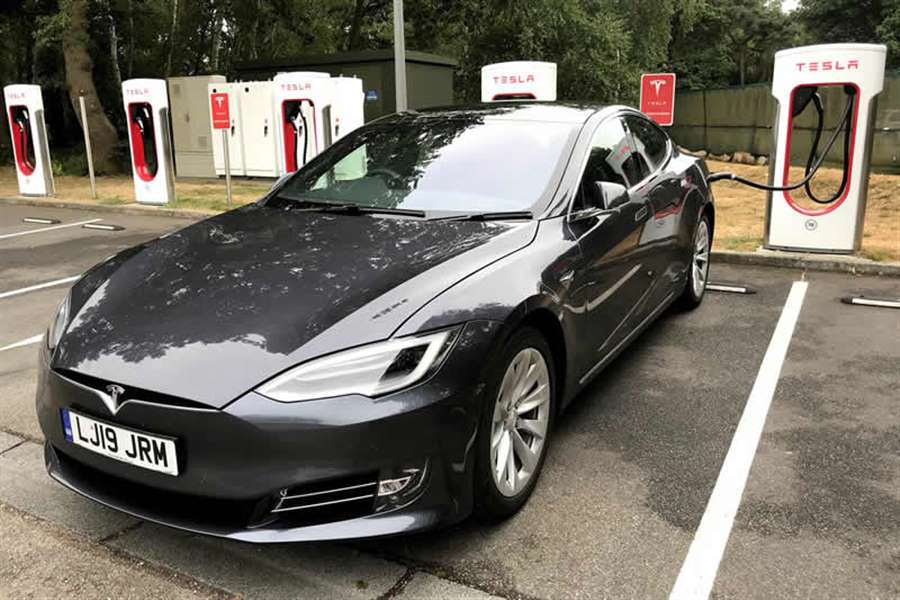
This car is quick, with a capital F. Tesla quotes a chunky 550bhp for the Long Range Plus and 615bhp for the Performance Ludicrous – both deliver supercar-baiting acceleration, pulling the four-door towards the horizon with all the inevitability of a silent, slightly eerie electric catapult. The Performance Ludicrous version is equipped with 4wd, it’s all drama-free and you’ll pass 60mph in 2.4sec – which is face-meltingly fast and lacking in drama.
Once you experience its stomach-churning thrust from rest, you'll crave to relive the experience – again and again. Of course, most Model S drivers wouldn’t condone such flat-footed antics. Not least because the claimed 396-mile range will freefall southwards if you drive like a hooligan.
Much better to ease off and surf the torque, preserving every precious mile. Driven like this, the indicated range is remarkably trustworthy and accurate in our experience – and we've driven them from one end of Europe to another.
Read our guide to the best electric cars and EVs on sale in the UK
Tesla Model S: What's it like to drive?
Out of the two models, we prefer the firmer-sprung Performance model, which has what Tesla describes as ‘European’ handling, and we'd agree with that. Yes, it's on the large side to be slinging around like a sports car on British roads – but get it on the right slowing, well-surfaced, roads, it does feel like a decently set-up model sports saloon.
Body roll is kept to a is kept in check, its air suspension doesn’t crash and get unsettled over every rut in the road, and its steering is accurate and quick, if lacking in road feel – overall, an impressive for the company's first serious effort.
Both Model S models get air suspension which results in relatively supple, forgiving ride quality. It also allows the Tesla to adapt on the move, lowering at higher speeds bringing it closer to the ground and further benefiting handling. The suspension can also be lowered via controls on the touchscreen, as well as being raised to traverse rougher ground and higher than normal speed bumps.
Further elements that aid the quest of good handling for the Model S are the fact its heavy batteries are all located nice and low, helping give it a very low centre of gravity. Further, the weight balance is almost split 50/50 front and rear, making it a neutral handler.
Final word goes to Tesla Autopilot, which works well once you've been through a lengthy period of acclimatisation. It rewards hyper sensitive drivers and feather-light inputs – assisted lanchanges take practice and some faith in the software, while the adaptive cruise control is a little on the fidgety side. If this is another step towards autonomy, we're still not sure we're ready to make the leap yet.
Verdict
The Model S continues to stun CAR’s testers. Sure, it's getting on, but it's still easy to recommend a Tesla Model S, despite the stern challenge from the beautifully-balanced, high-quality Porsche Taycan. Beyond The Model S's good looks, fabulous performance, and silky-smooth drivetrain, the lure of free Supercharging is almost irresistible.
It's interesting that even with new rivals appearing all the time, the Model S's appeal remains pretty much undented. The Tesla's combination of easy-to-use technology, Supercharger network and impressive range still place it ahead. Yes, you pay handsomely for the Model S if you option it up, but its entry-level isn't that far beyond the price of the a high-spec Audi A6 or BMW 5-series.
After all these years, it's still a gamechanger. The Model S has been largely responsible for consumers warming to the idea of an electric vehicle with so few compromises. It won't be long before the EV will be viable for most people – and you can thank the pioneering Model S for accelerating that process.
Source: carmagazine.co.uk
-
Tesla Model Y SUV review
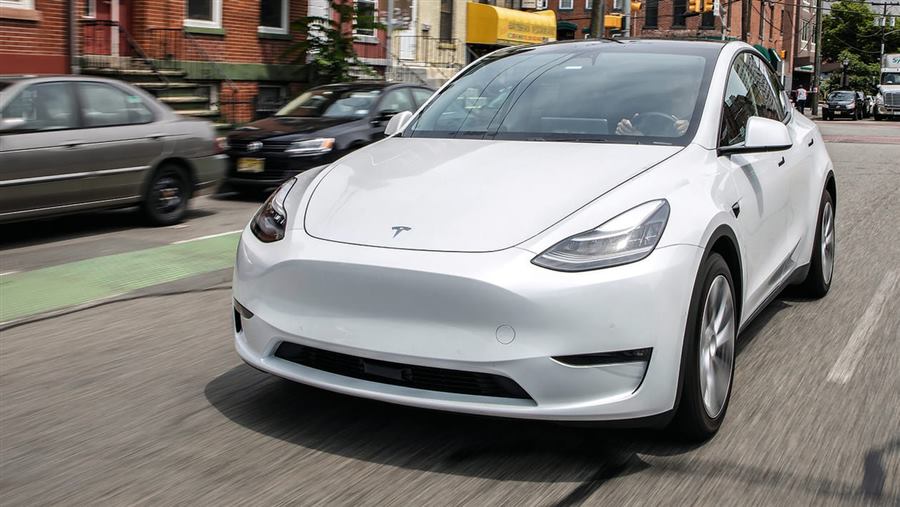
"The Tesla Model Y takes what makes the Model 3 great and adds SUV practicality"
Pros
- Fast and efficient
- Spacious interior
- Hatchback boot
Cons
- Delayed for the UK
- Patchy build quality
- Limited model lineup
The Tesla Model Y has all the ingredients to be a hit when it eventually arrives on UK shores. The Tesla Model 3 has already struck a chord with buyers, appearing in the list of top-selling cars during 2021 and scoring well in our Driver Power owners satisfaction survey. Adding SUV style and space is only likely to make the recipe more desirable.
There's certainly enough hype around the brand but Tesla does risk missing the boat. Instead of arriving as a trailblazer, the Model Y will find itself competing against the Volkswagen ID.4, Skoda Enyaq iV, Ford Mustang Mach-E, Audi Q4 e-tron, Mercedes EQA and Ioniq 5. In other words, just about every mainstream manufacturer has realised it needs to sell an electric SUV and many of them are already available.
Part of the reason for the delay is Tesla CEO Elon Musk's desire for European examples of the Model Y to be built at a new Tesla Gigafactory in Germany, the completion of which has faced significant hold ups. The Y began arriving with the first American customers in March 2020.
When the Model Y does arrive here, there's likely to be a Long Range and Performance model, sticking closely to the Model 3 on which the car is based. Both versions offer impressive acceleration and four-wheel drive but it's the Performance that's likely to be faster than any rival, with 0-60mph taking around 3.5 seconds.
The Long Range will be capable of around 314 miles between charges, thanks to its smaller wheels and slightly reduced performance, while the Performance will have a range of around 298 miles. These are impressive numbers but according to official figures, they're no longer class-leading, with the Mustang Mach-E capable of up to 379 miles in its most efficient specification.
Inside, the Model Y has the same minimalist interior and technology as the Model 3, focused around a high-res 15-inch touchscreen in the middle of the dashboard. Air vents have been replaced by a narrow slot and leather by vegan-friendly materials. It works well once you get used to its controls but quality isn't on the same level as the top European manufacturers.
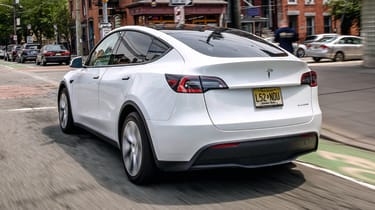
A taller roof means there's more space and headroom inside the Model Y than the Model 3, while its hatchback boot is much more useful for loading luggage or sports equipment. However, the Enyaq's boxy shape makes it even more accommodating.
We'll need to spend time behind the wheel of a Tesla Model Y in the UK to deliver our final verdict but we suspect fans of the brand and families alike will love the Model Y even more than the 3. Tesla should be worried, however, that the market for electric SUVs is getting significantly more crowded as the wait for the Model Y continues.
MPG, running costs & CO2
When the Model Y arrives, it's likely to be in Long Range and Performance versions, both of which have the same size battery. Thanks to smaller, 19 or 20-inch alloy wheels and less power from its electric motors, the Long Range is expected to have a range of around 314 miles. Step up to the Performance version, and 22-inch alloy wheels and more power reduce range to just under 300 miles.
The Skoda Enyaq iV has a shorter 256-mile range with its 62kWh battery but just beats the Model Y with between 327-333 miles if the largest 82kWh battery is fitted. Meanwhile, the Volvo XC40 Recharge can manage up to 259 miles between charges, which is some way behind the Ford Mustang Mach-E - that car’s capable of up to 379 miles.Both the Long Range and Performance models take just under 12 hours to charge from empty to 100% using a 7.4kW wallbox, while a rapid charge at 250kW can take the battery from 10 to 80% in just 19 minutes. Another draw is the Tesla Supercharger network of public chargers, which won our 2020 Best chargepoint providers survey, coming top in every category.
As with all EVs, the Model Y is exempt from VED (road tax) but the biggest savings will be for business users, thanks to very low Benefit-in-Kind liability. This can save company-car drivers hundreds or even thousands per month compared with petrol and diesel models.
Engines, drive & performance
While Tesla hasn't revealed the exact power of the Model Y destined for the UK market as yet, the Performance version is expected to get the same 455bhp as the Tesla Model 3 Performance. Nobody is ever likely to describe it as lacking in speed, with a 0-60mph time in the region of 3.5 seconds and a top speed of 150mph. There's instant acceleration when you press the throttle, followed by sustained acceleration that a Mercedes-AMG C63 or BMW M3 would struggle to match.
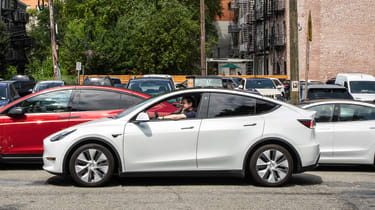
The Long Range version isn't quite as unhinged, with around 345bhp getting it from 0-60mph in just under five seconds and on to a top speed of 135mph; step out of the Model Y Performance and it almost feels slow. The car feels taller than the low-slung Model 3 but there's still almost no body lean in corners, thanks to the low centre of gravity of the battery pack beneath your feet. There's some feel of the wheels and road through the steering too, keeping the driver in touch with what the Model Y is doing.
Regenerative braking as you release the accelerator can be adjusted and in its maximum setting, it slows the Model Y noticeably, negating the need to use the brake pedal in most circumstances. It takes a bit of getting used to when first making the switch from a petrol or diesel model but quickly makes sense and can become rather addictive as energy is put back into the battery to improve range.
Interior & comfort
The Model Y's interior is virtually identical to the Model 3, although you will notice the extra headroom. The raised seating position also makes getting in and out easier, and the extra space helps the Model Y feel airier inside, especially for those in the back seats, who also get to enjoy a larger panoramic roof.
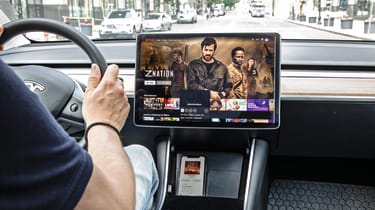
The dashboard is the epitome of minimalism, with just a large central touchscreen; if you look through the steering wheel there are no dials or screens . Everything from the media system to the climate control and wipers are controlled either by the screen, controls on the steering wheel or column stalks. The 15-inch display is impressive, with Tesla's own software that works well and is frequently updated. It also has some pretty unique features, including the ability to show streaming entertainment like Netflix while parked up or play console-style computer games.
It's not perfect, however, and material quality is still off the pace of rivals like the Audi Q4 e-tron, Mercedes EQC and Jaguar I-Pace. It's also likely that trim options will be limited for the Model Y when it arrives in the UK, with far fewer ways to add features or personalise the interior than those offered by manufacturers like Audi.Practicality & boot space
We've mentioned that the Model Y's taller roof means passengers have more headroom than in the Model 3, which makes it possible for adults to sit comfortably in the back seats. The electric 'skateboard' under the car helps here because there's less intrusion into the interior, resulting in a flat floor and a longer interior than that of a traditional SUV of a similar size.
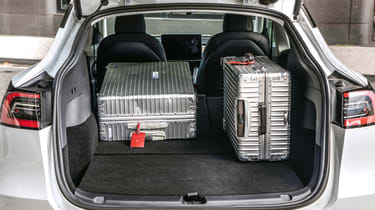
Along with its SUV looks and raised seating position, most buyers will choose a Model Y for its improved practicality. Along with its frunk (storage space under the bonnet), a hatchback tailgate is likely to appeal to UK buyers more than the Model 3's saloon version, creating a much bigger opening to load in bulky items. Its three-part rear bench also folds down electronically. Tesla has also hinted that a third row will be available to make the Model Y a seven-seater but this hasn't been confirmed yet, and it also doesn't look like there'll be much space, so they're likely to be limited to children.
Reliability & safety
While the Model Y hasn't appeared in our Driver Power reliability survey yet, the Model 3 came 18th out of the top 75 models. However, strong scores in other areas offset a poor performance for exterior and interior build quality. It scored very highly for running costs and gained a category win for its powertrain, while practicality also impressed - an area in which the Model Y should do even better.
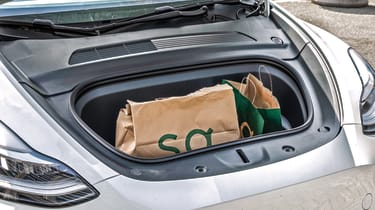
It's a similar story for safety, where the Model 3 has been crash-tested but it's unlikely the Model Y will be scrutinised by Euro NCAP just yet. The Model 3 scored an impressive 96% for adult occupant protection, along with a very high 94% rating in the Safety Assist category.
The Model Y also gets the same Autopilot semi-autonomous driver aids, so it's covered in numerous sensors and cameras that can help the driver avoid collisions and take over some driving tasks on well-marked roads.
(carbayer.co.uk)
-
Tested: 2021 Volkswagen ID.4 Seeks to Normalize Electric Cars
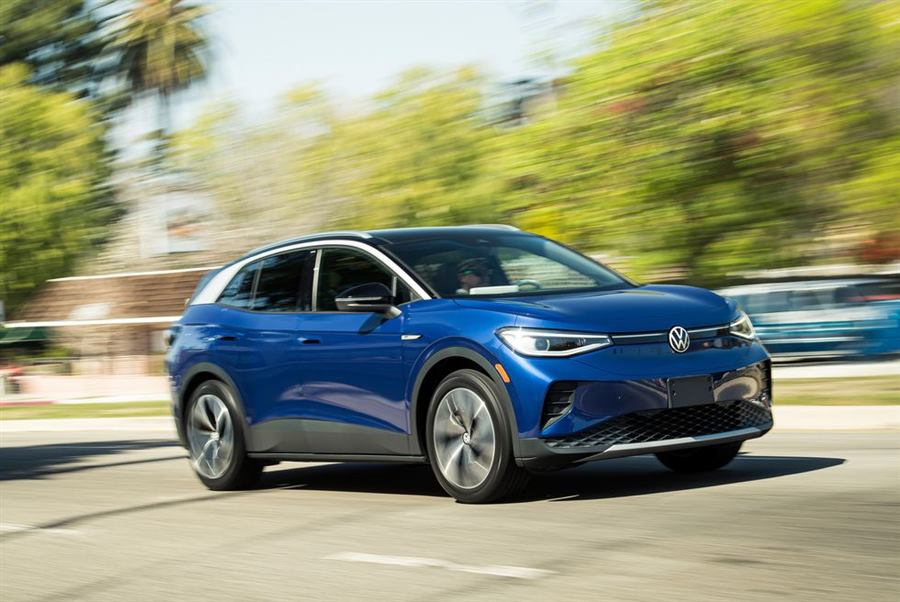
VW's electric crossover succeeds at imitating the gas-powered competition but forgoes many of the things we like about EVs.
As electric cars begin to proliferate, we are seeing the auto industry figuring out the best way to build and sell battery-powered cars. Some take existing gasoline models, rip out their powertrains, and bolt in battery packs and electric motors. A few existing carmakers have started new EV-only brands to market purpose-built electrics. One brand is courting the attention and controversy that comes from putting a famous pony-car nameplate on an electric car. And then there are the startups whose big promises are only outdone by the cultlike devotion of their fans. Against this backdrop, VW's approach for the new ID.4 looks extremely logical and straightforward. The 2021 ID.4 is designed and engineered to be an electric crossover that matches the specifications, performance, and character of the best-selling gas vehicles in the United States: compact SUVs such as the Toyota RAV4 and Honda CR-V.
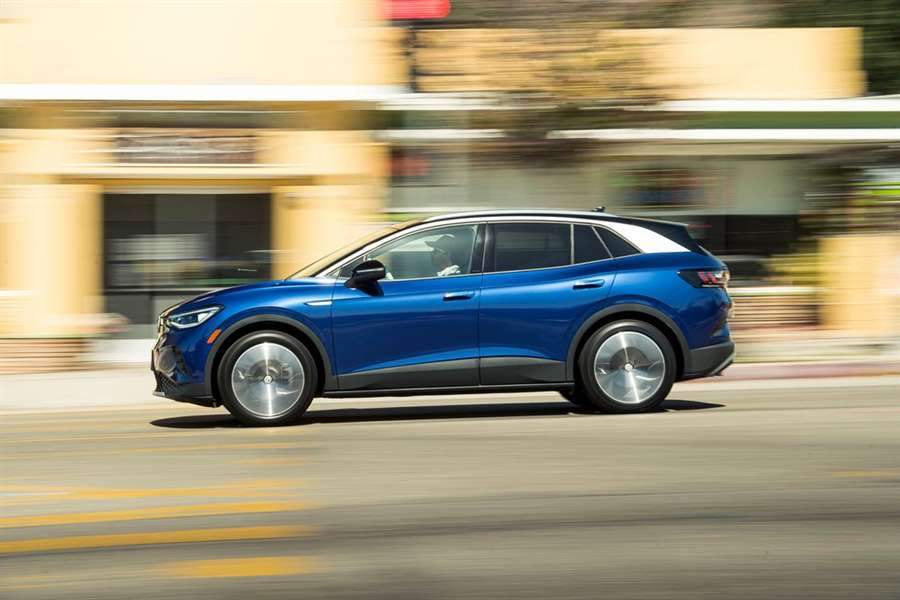
Built on the VW Group's new MEB modular EV platform, the ID.4 has a 77.0-kWh lithium-ion battery pack under the floor and a 201-hp electric motor on the rear axle. While this layout is unusual for the compact crossover-SUV segment, the ID.4's dimensions make it a lot like the rest of the class. The VW's wheelbase is longer, but its length and width are within fractions of an inch of the RAV4's. The ID.4's design hardly advertises its electricness and isn't any more eye-catching than your average crossover. It's shaped like a two-box blob with conventional-looking headlights and taillights. The only bits of flair are in the grilleless face and the optional contrasting C-pillar trim.
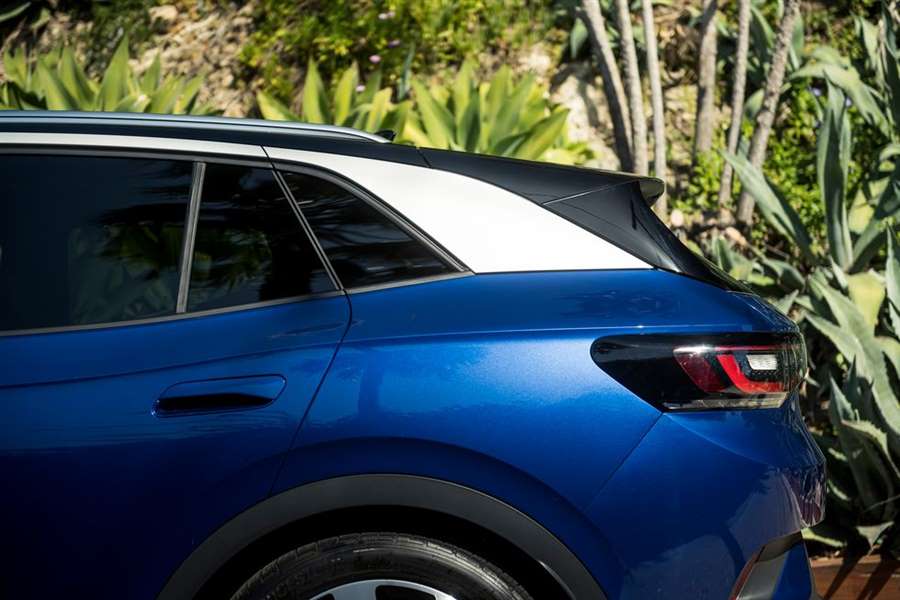
HIGHS: Spacious interior, comfortable ride, quiet at speed.
The ID.4's primary controls are set up to mimic the experience of a gas-powered car. Sit down, turn a knob to put it in Drive, and you won't have to make any adjustments to your driving behavior. Let your foot off the brake and it creeps forward just like a gas car with a torque-converter automatic transmission. Lift off the accelerator and it continues to coast like a gas car with an automatic.To get more braking from the electric motors requires putting the car into its "B" setting, but even in that mode the regenerative braking effect isn't aggressive enough to reliably slow the car with a lift off the accelerator or to bring the ID.4 to a complete stop. Volkswagen promises one-pedal driving in B mode, but our regular use of the brake pedal had us questioning the brand's definition of the term.
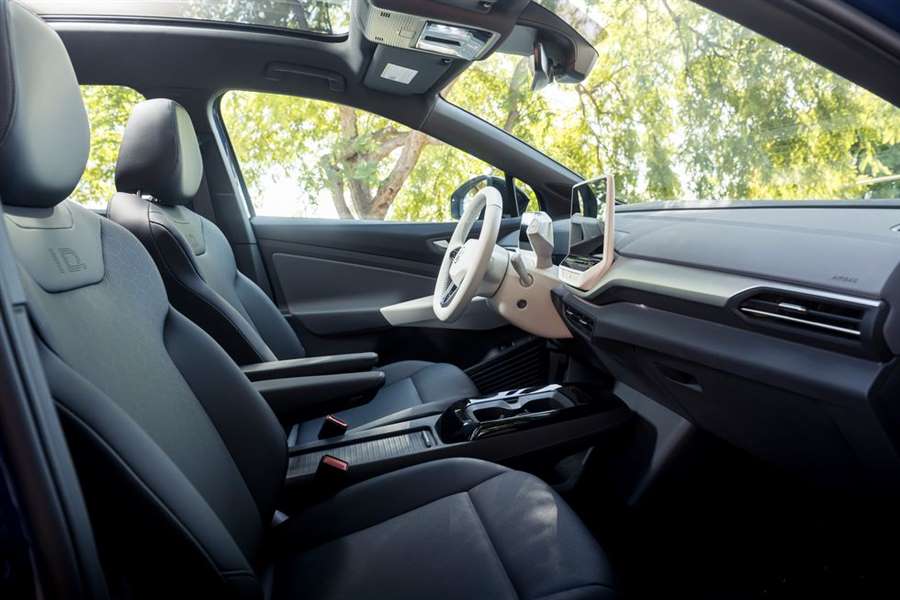
VW also touts ID.4's 201-hp electric motor as having about the same power as the base four-cylinder engines in many compact crossovers. Maybe so, but the ID.4 weighs 4698 pounds. That's a whopping 1000 pounds more than the gas-powered competition. With only 229 pound-feet of torque, the neck-snapping shove of instant torque we like so much in electric cars is largely missing. When merging or passing at highway speeds, the ID.4 feels sluggish. The run to 60 mph takes 7.6 seconds, and the quarter mile is complete in 16.0 seconds at 86 mph, on par with the quicker gasoline models in this segment but significantly slower than similarly sized EVs such as the Ford Mustang Mach-E and Tesla Model Y. A more powerful dual-motor all-wheel-drive version of the ID.4 with around 300 horsepower will be available later this year and will likely bring the ID.4 closer to the snappy acceleration of other EVs.
LOWS: Unexciting to drive, anonymous styling, annoying infotainment.
If you are excited about the handling prospects of this rear-drive configuration, don't be. The ride is pleasingly firm and the steering is appropriately weighted, but there's little verve or joy to the driving dynamics. The ID.4 simply goes where it's pointed without complaining, which, to be fair, is what's expected of a small SUV. We recorded 0.85 g of grip on the skidpad and a stopping distance of 166 feet from 70 mph, average numbers for the class.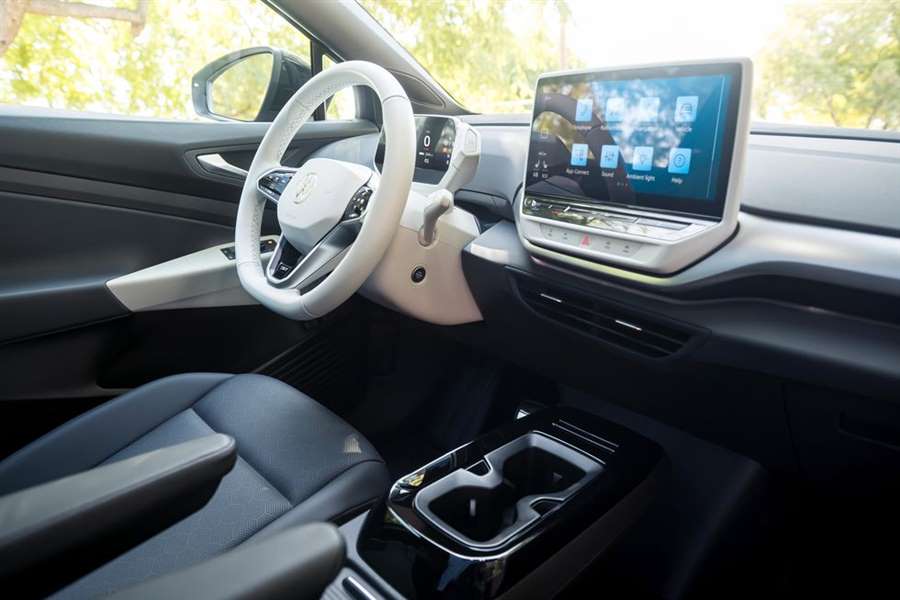
Driving the ID.4 is a largely serene experience. At 70 mph we measured a library-like 68 decibels, and the powertrain remains hushed under acceleration. The interior is airy and spacious, with a low beltline and a generous rear seat. There's no "frunk" as in many other EVs, but the cargo area behind the hatch is big, fitting eight carry-on suitcases with the rear seats up and 26 cases with the seats folded. The front seats are good for hours, and the driving position is natural, with good visibility. Storage cubbies abound, and rear-seat passengers enjoy their own USB ports and air vents.
The least conventional aspect of the ID.4 is the one you'd most hope to follow convention: the user interface. We're not fans of VW's latest infotainment software, which is overly reliant on the 12.0-inch touchscreen and doesn't provide enough physical controls for things you want quick access to such as heated seats and radio tuning. There are touch-sensitive sliders for the climate controls, sunshade, and volume adjustment, and haptic buttons for various menus. Even the few physical controls are strange. There are only two window controls on the driver's door panel, and you must press a finicky haptic switch to activate the rear windows. And the clean look of the white steering wheel isn't going to stay clean for long.
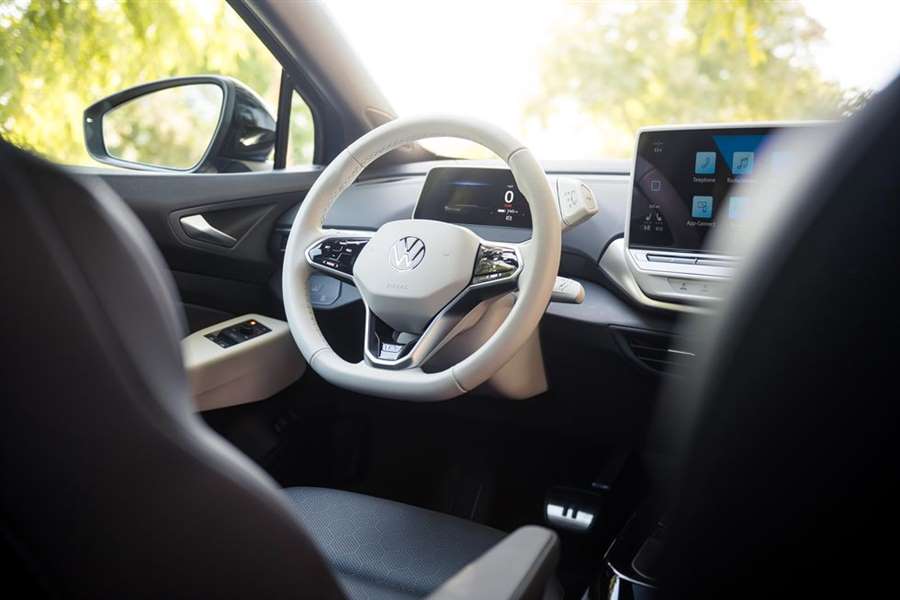
The driving experience in the ID.4 is so normal that it's easy to forget that there's nothing for you at a gas station except Flaming Hot Cheetos. The EPA claims a 250-mile range in combined driving, and we measured 190 miles in our real-world 75-mph highway range test done just above freezing temperatures. (Cold temps negatively impact battery range.) Refilling the VW's battery from empty takes about 7.5 hours on a typical 220V charger, and fast chargers can get you from 5 to 80 percent charge in a claimed 38 minutes. Thanks to Dieselgate, VW is investing heavily in charging infrastructure through its subsidiary, Electrify America. Buyers benefit from the scandal with three years of free charging from Electrify America's fast chargers.
Early adopters of new tech might be disappointed by the ID.4's lack of quirkiness. The ID.4 feels like it's trying to convince buyers that an EV can cost and provide the same experience as mainstream gas-powered vehicles. Pricing starts at $41,190, and our 1st Edition test car stickered for $45,190, which is within reach of loaded gas-powered compact crossovers, especially when you factor in thousands of dollars in federal tax credits.
Rather than an electric vehicle shaped like a compact SUV, this Volkswagen feels like a mainstream crossover that happens to have an electric motor and a battery pack. But the ID.4 lacks any distinct advantages over gas models, and it's missing the cool factor and instant-feeling acceleration of other EVs. VW is so determined to make the ID.4 normal that it seems to have forgotten that EVs can be weird, funky, and fun. The ID.4 is a quiet and comfortable transportation pod that will satisfy buyers looking for a quiet and comfortable transportation pod.
-
The new electric Volvo and the announcement of the end for petrol and diesel
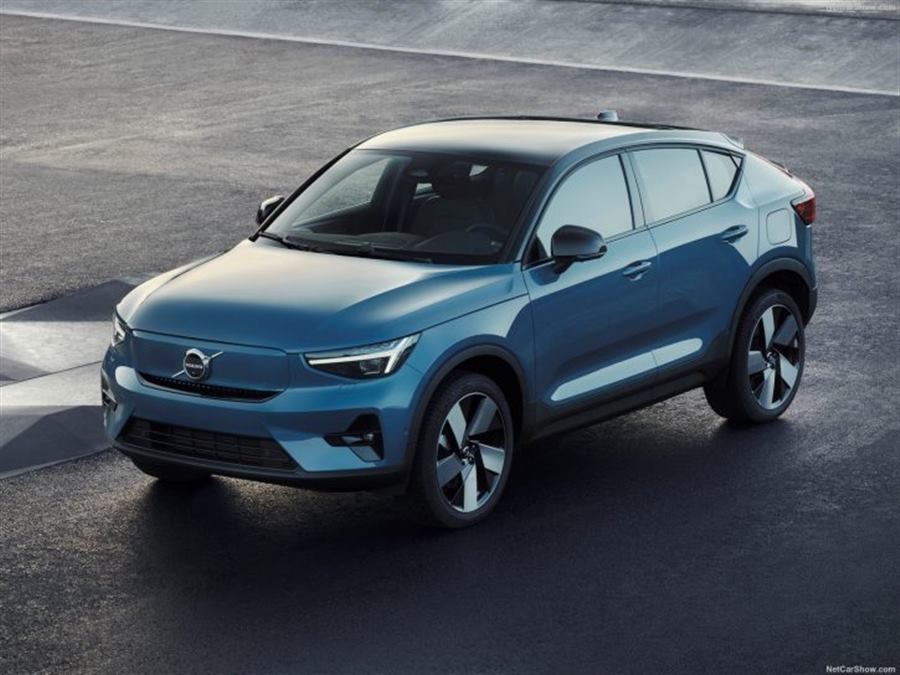
After Jaguar Land Rover, Bentley, GM, Ford and others, Volvo has now announced that from 2030 it will produce exclusively electric cars. That's why they accelerated a bit, so today the second electric model of the company was shown - C40 Recharge.
Moreover, the Swedish brand plans that from 2025, half of the sold Volvo cars will be powered by electricity, and the other half by hybrid drive.
This means that in just four years, they will stop selling models powered exclusively by SUS petrol or diesel engines. And whoever decides to buy a new Volvo in ten years, the only models that will be available will be electric.
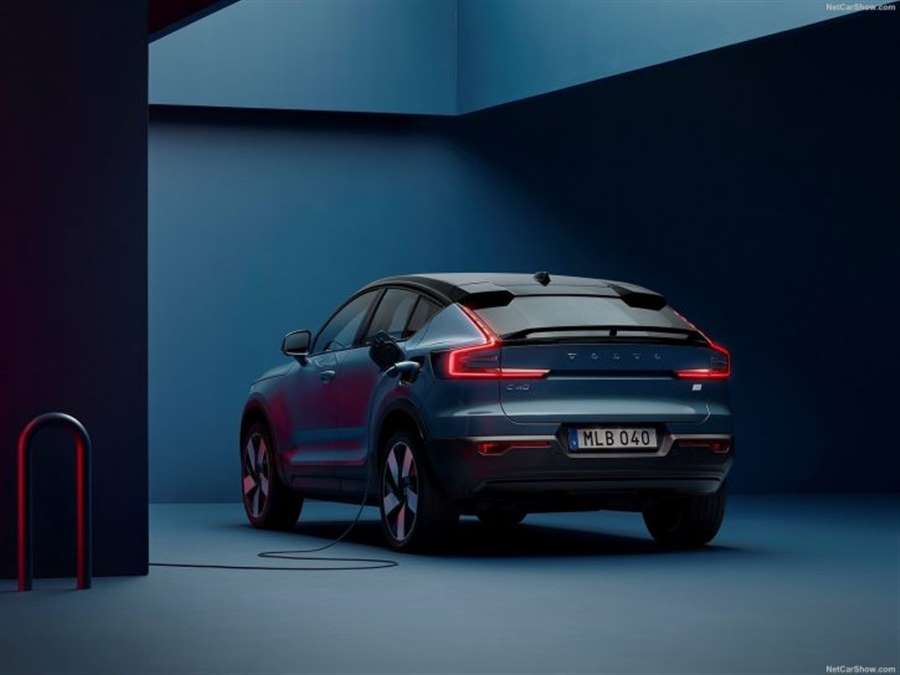
Volvo is owned by the Chinese company Geely, from which it has been confirmed that the conventionally powered models will be on sale only for a while longer, all in order to meet the stricter standards on harmful gas emissions, writes CNN.
It will be a very difficult task for a company that literally has 2 electric cars as of today - the famous XC40 Recharge and the C40 Recharge introduced today.
The new coupe-SUV is based on the XC40 Recharge model, but is slightly lower than it. In addition to a more attractive design, it also has two powerful electric motors with a total power of 408 hp. The 78 kWh battery provides a range of about 420 km, and a charging time of up to 80% is 40 minutes. The new electric model will cost just over £ 50,000.
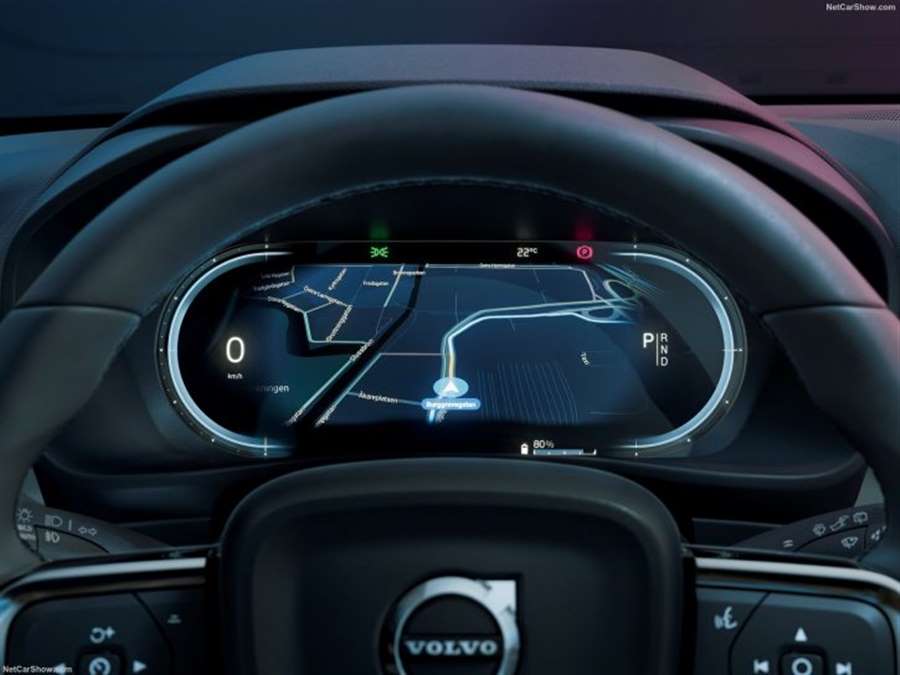
The head of Volvo announced that in addition to the new electric model from the 40 series, more novelties will arrive in the years ahead. As they pointed out from the Sino-Swedish company, they will work a lot on the development of the autonomous driving system.
Another interesting fact that they made public is that the new electric Volvo cars will be sold exclusively online, which already applies to the new C40 Recharge. Investing in online sales will further reduce costs, and after all, a similar strategy is being implemented by Tesla, whose models are officially sold exclusively online.
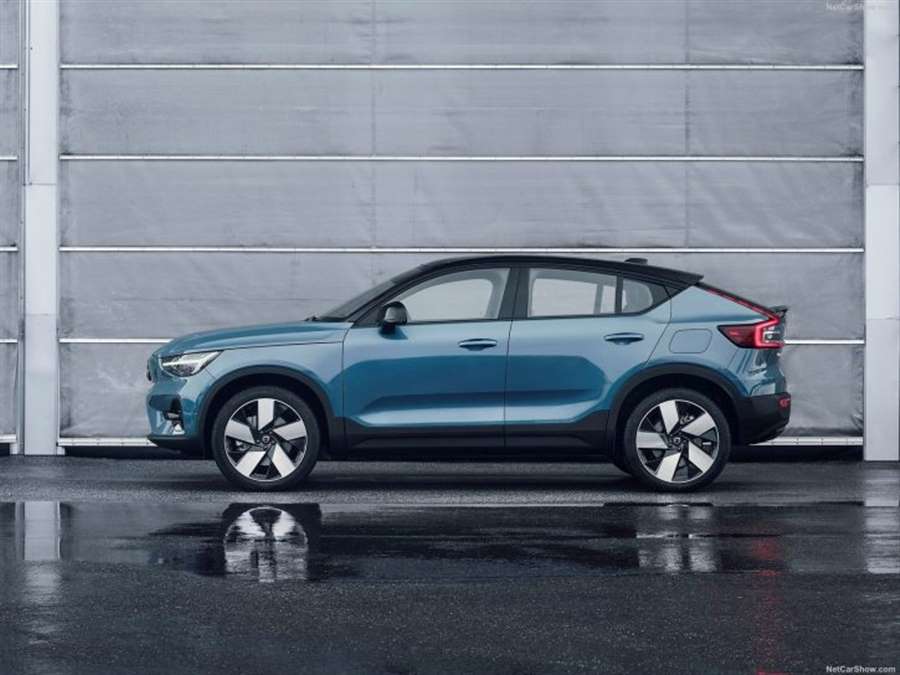
We remind you that many other car companies have recently started announcing plans for a significant acceleration towards full electrification of the market in Europe.
Among them are Daimler, Ford (which will cooperate with VW), JLR and others, while Tesla's first factory in the EU, which is being built in Berlin, will also contribute to this trend.
Also, it is expected that the production of electric cars will be cheaper compared to conventional ones, both due to the new generations of batteries and the smaller number of parts that would be transported and, therefore, the smaller number of workers needed for assembly.
-
Vauxhall Vivaro-e Life review
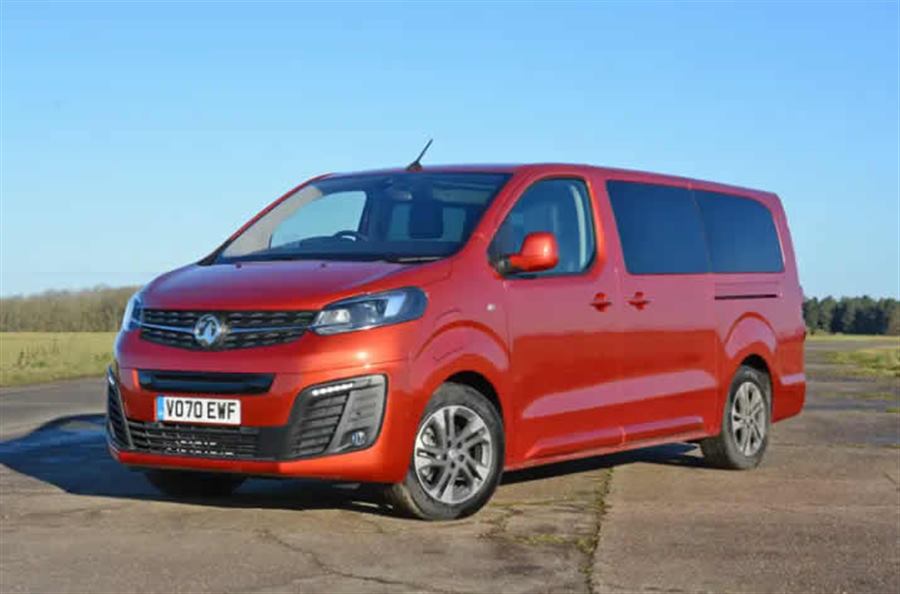
Electric people carrier’s appeal limited by battery size
One of the most recent additions to the ranks of electric cars is the battery powered Vauxhall Vivaro-e Life, a zero-emission range to compliment the pre-existing diesel-only Vivaro Life range.
Plug-in cars enjoyed an enormous sales growth during 2020, largely at the expensive of diesel models, making a comparison of the relative virtues of these otherwise similar models particularly pertinent.
Just as the diesel Vivaro Life is a passenger-carrying MPV version of the latest Vivaro panel van, so it is with the electrified models, albeit with different battery capacities for the commercial Vivaro-e as covered throughout this review.
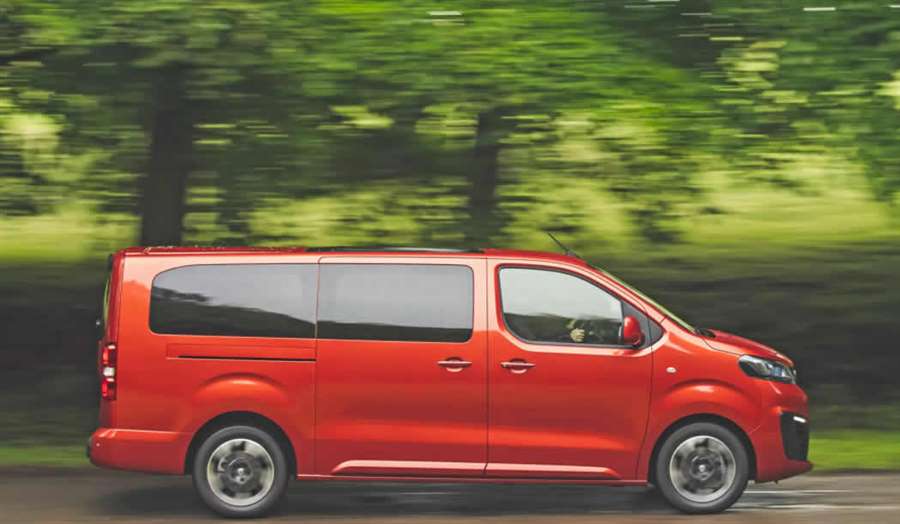
Direct rivals aren’t numerous at this stage, but they include the Citroen e-SpaceTourer and Peugeot e-Traveller, which, aside from styling differences at the front and a small number of detail changes, are identical to the Vauxhall. Interestingly, Toyota will not offer its equivalent version of the Proace Verso, even though it will sell an electric Proace van.
If you want something based on a totally different design, but still electric, your sole alternative (for now, at least), is the Mercedes-Benz EQV – a BEV version of the V-Class with a flurry of minor styling modifications.
What is the Vivaro-e Life’s driving range
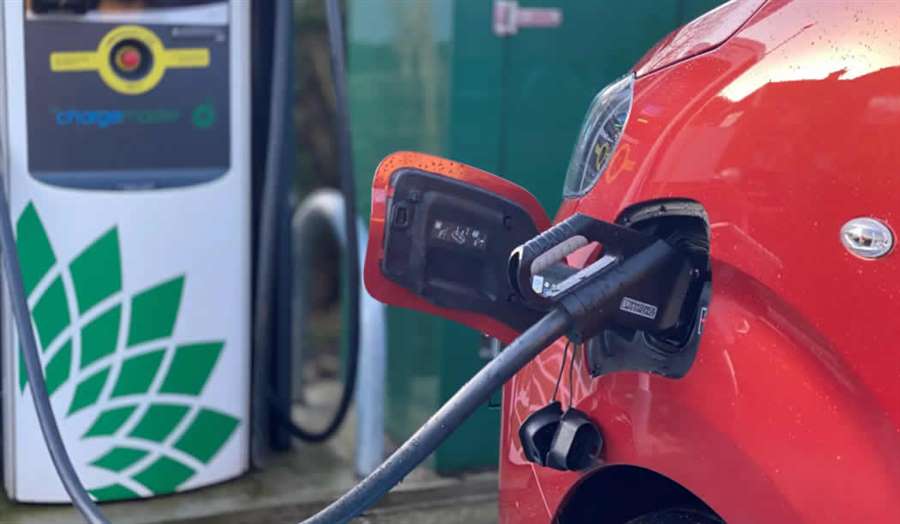
In a word, disappointing. Primarily this is because its battery pack, which is conveniently hidden under the floor and has zero impact on interior space, has a capacity of 50kWh. That’s fine in a more compact hatchback such as the electric Vauxhall Corsa-e, but in something the size of the Vivaro it restricts the distance it can travel between recharges badly.
Officially the range is 144 miles, but in the sub-zero temperatures we’ve tested the Vivaro-e Life in so far, it would only charge up to a displayed 128 miles, with a real-world range on a mixture of roads of 100.
That could be sufficient if it's being primarily for urban journeys as a taxi, but as a family bus it’s disappointing.
Frustratingly, Vauxhall doesn’t offer the electric Life with the same 75kWh that’s available in the Vivaro-e van. In the commercial application the range jumps to a more sensible – if not exactly startling – 205 miles, just shy of the Mercedes EQV at 213 miles.
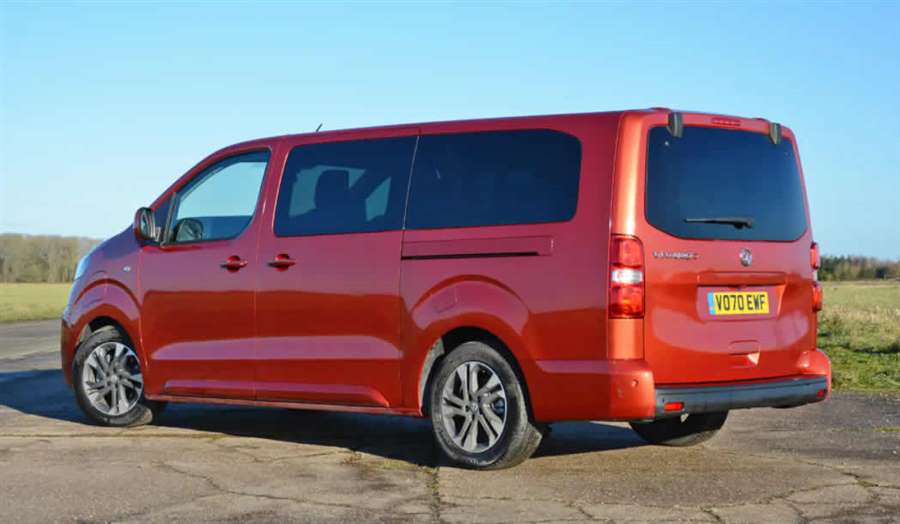
As ever recharge times depend on your connection, with a flat-to-full replenishment using a dedicated domestic wallbox taking 7.5 hours. On test, we found a ‘very low’ to full zap-up using a 50kW public charger could be done in around an hour.
Simple Vivaro-e Life line-up
With two trim levels – Edition and Elite – the electric Vivaro Life mirrors its diesel-engined twin, but beyond that the choice is even more straightforward.
Only one length of body is available (the longer one), there’s one 136hp electric motor option and it comes with a single-speed automatic transmission.
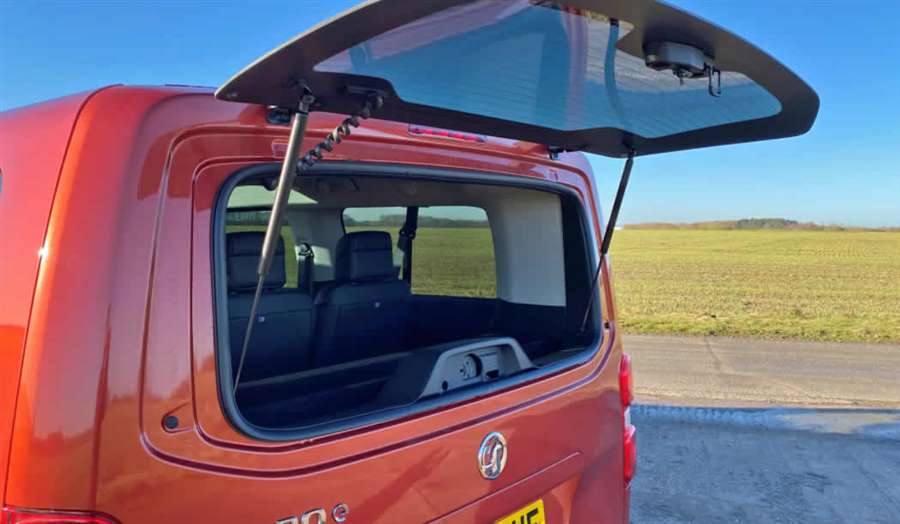
Entry-level Edition versions are easy to spot thanks to their largely unpainted bumpers and exterior mouldings, plus steel wheels with a plastic centre cap.
With a twin front passenger bench and three-person benches in rows two and three, the Edition is a nine-seater and not remotely plush inside. It’s aimed much more at private hire operators, businesses that shuttle employees around and families needing a large car on a budget, Air-con, cruise control and Bluetooth connectivity are included, but little else is as part of this sparse package.
Spending an extra £12,000 brings you a wealth of niceties rather befitting the Elite name. Among the long list of standard fare is a glazed roof panel, three-zone climate control, eight seats with a conventional, single-person, front passenger seat, leather upholstery, keyless entry, electrically sliding side doors and 17-inch alloy wheels to name but a few.
Should you wish to up the luxury ante a little more the middle-row bench seat can be replaced by a pair of captain’s chairs, complete with armrests and complemented by a fold-up table installed between them.
Comfier than diesel Vivaro Lifes
One of our chief critiques of the diesel counterpart was how unsettled the ride quality is when there are no passengers in the back.
Thanks to the weight of the batteries in the electric version, this is far less of an annoyance and in the most part isn’t an issue at all.
Not that you remotely buy a van-derived car such as the Vivaro-e Life for driving thrills, the weight of the batteries being so low within the vehicle’s structure also has a positive impact on how well it drives.
Nevertheless, it remains a car that’s easier to enjoy as a passenger rather than the driver, but none of the flaws of its diesel twin have been ironed out in the conversion to being an electric model as we describe later in the review.
Ordinarily, electric cars cost significantly more than their conventionally engined counterparts, but here the differential is around £3,000 – a very small figure to recoup in fuel savings.
-
Volkswagen has opened a plant for recycling car batteries
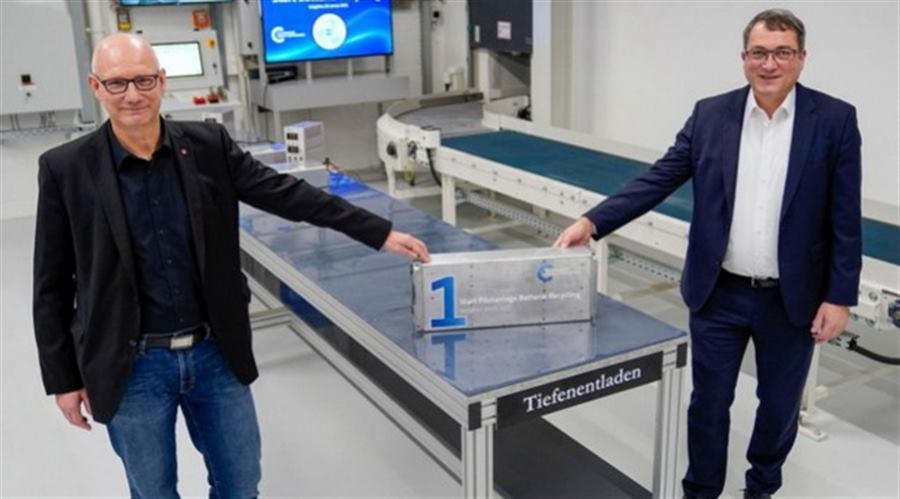
Volkswagen's Group Components division has opened its first plant to deal exclusively with car battery recycling.
The plant is located in the German city of Salzgitter and has started a recycling pilot project. The goal of the project is to take old lithium-ion batteries used in cars and extract useful raw materials such as lithium, nickel, manganese and cobalt, and to extract aluminum, copper and plastic. In this way, in the ideal scenario, up to 90% of all battery components could be recycled.
Only car batteries that can no longer be used for any other purpose will be recycled in this plant. Namely, during this kind of ecological care, an analysis will be conducted. It will show whether the used battery is still capable of providing enough voltage for its "second life" in long-term energy storage systems, mobile vehicle charging stations and the like. If the analysis shows that the battery is no longer suitable for that, it will be sent for recycling to Salzgitter.
For now, as part of the pilot project, it is possible to recycle up to 3,600 batteries from electric cars a year in this plant. As e-vehicles gain in representation, so will the recycling drive, designed so that its capacity can be increased. Only by the end of this decade, they say from Volkswagen, will the recycling of batteries be carried out in significant quantities here.
What is important for this process is that it is in line with the environmental goals of the Volkswagen Group. VW plans to thoroughly discharge the batteries in the recycling process and disassemble them into their component parts. They are then ground into granules and dried, resulting in the so-called. "black powder" - composed of lithium, nickel, manganese, cobalt and graphite. These elements are separated from the powder by chemical hydrometallurgical processes, dissolution in water and chemicals, which will be carried out by several partners for Volkswagen.
In the end, raw materials for the production of new battery cathodes will be obtained from valuable materials from old batteries. VW calculates that by using recycled materials and renewable energy sources when making a new average car battery, with a capacity of 62 kWh, it will save 1.3 tons of CO2 that will not end up in the atmosphere.
Author: SEEbiz / Bug.hr
-
Volkswagen started producing another electric SUV: ID.5
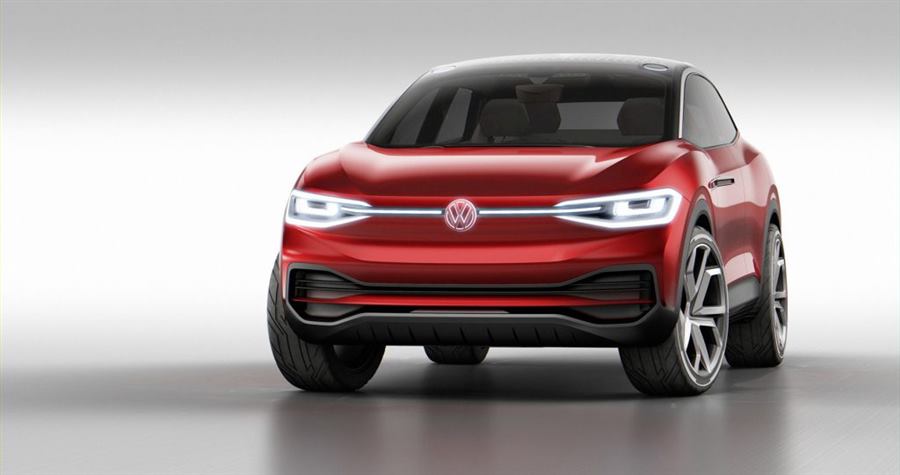
Production of the first pre-series copies of ID.5 has begun, while the start of production of models intended for the market is expected in the second half of the year. The new model should be reminiscent of the ID.Crozz concept, and it is certainly a coupe version of the already known Volkswagen electric SUV - ID.4.
The German car giant Volkswagen continues with the offensive on the electric car market, so it has already started the production of the third electric model based on the MEB platform, reports zimo.dnevnik.hr.
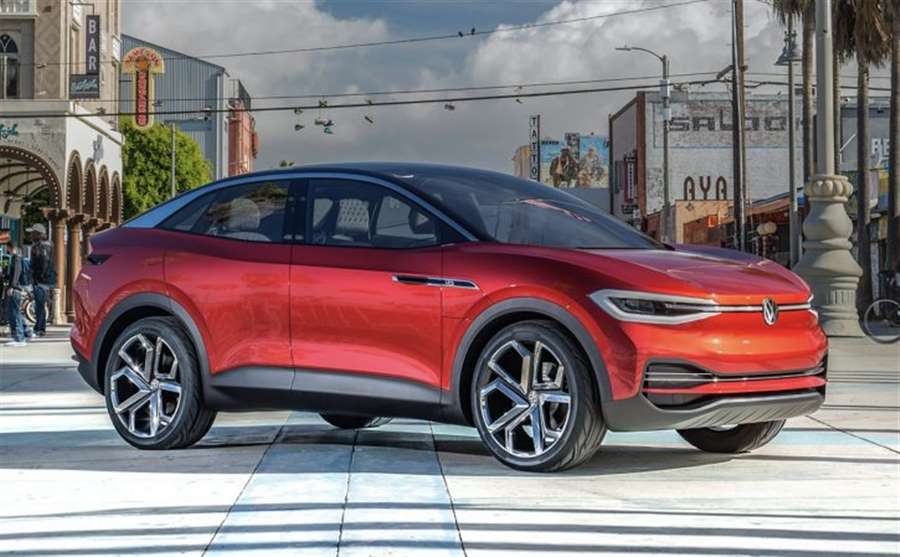
Sales of the ID.3 model (which should play the role of an electric Golf on the market) began last year, followed by the compact ID.4 SUV. Several other models are in preparation, such as the family ID.6, whose photos were recently leaked in China, and which you can see here, and ID.2 is mentioned. However, the first comes next - ID.5, an attractive SUV in the form of a coupe.
As ID.5 is not yet official, there is no data on its performance, but according to rumors, this will be a coupe version of the ID.4 model, which should look like the ID Crozz concept.
Although it has not been officially presented yet, the German company confirmed that the production of pre-series models has already started, while the production of the final versions is expected in the second half of the year.
Interestingly, like the ID.3 model, the "five" will not be intended for the United States, but the primary market will be European.
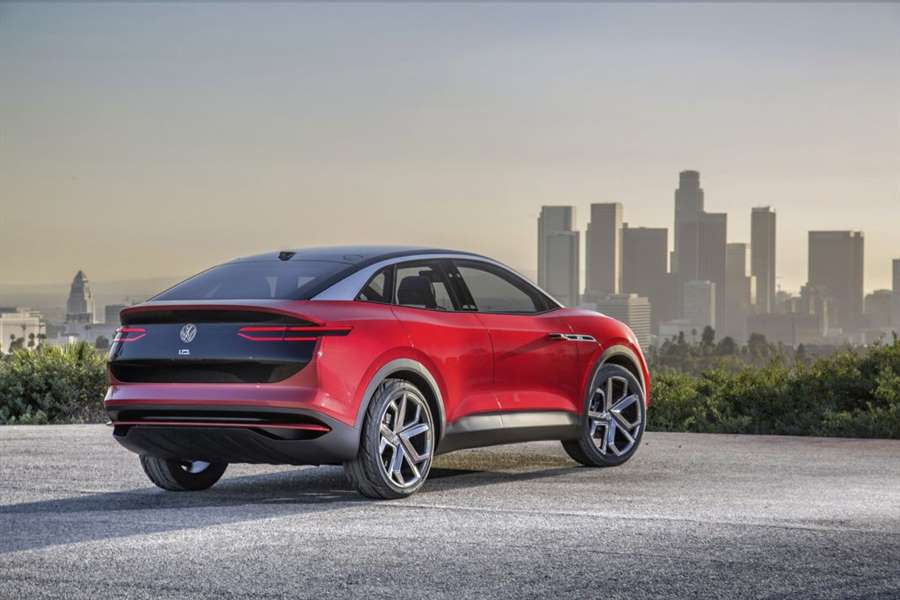
In terms of options and performance, it is speculated that the figures will be similar to those on the ID.4 model. Thus, the 150 kW engine that drives the rear wheels is mentioned (versions with two engines and all-wheel drive will appear later), as well as the 77 kWh battery.
Given that the start of production is expected in the second half of 2021, it is clear that Volkswagen will not wait too long until the official presentation of this model.
Pictures of the concept on which ID.5 is supposedly based indicate that this may be the most attractive electric "Volkswagen" which, if the price is not too high, could really achieve great market success, and perhaps be a bestseller in the e-SUV class. German companies.
-
Volkswagen wants to sell over 100,000 electric ID.4s in 2021
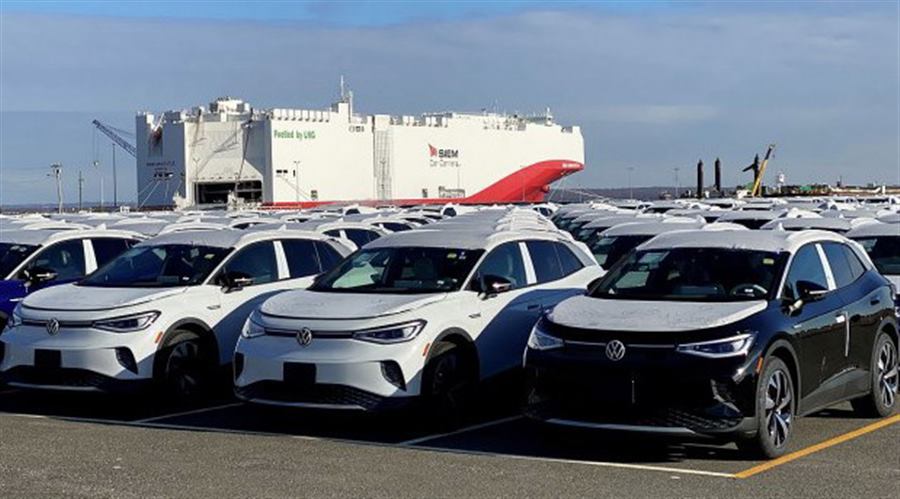
The first contingent of the ID.4 crossover set off on its way to its future owners in Europe, China and the United States.
The Volkswagen ID.4 is the second production model of the new generation of electric vehicles manufactured by Wolfsburg, after the ID.3 that broke the ice last year. Both cars are based on the MEB mechanical platform developed by VW specifically for electric vehicles.
According to B92, optimistic forecasts are coming from the German manufacturer that it should deliver over 100,000 copies of the ID.4 crossover to customers this year alone, although they have received only about 17,000 orders so far. The VW ID.4 is currently being produced at the Zwickau plant in Germany, as well as in China, and will soon start production in Emden (Germany) and, next year, in the Chattanooga factory (USA).
-
Volvo from 2030 on electricity only. And the possibility of shopping only online
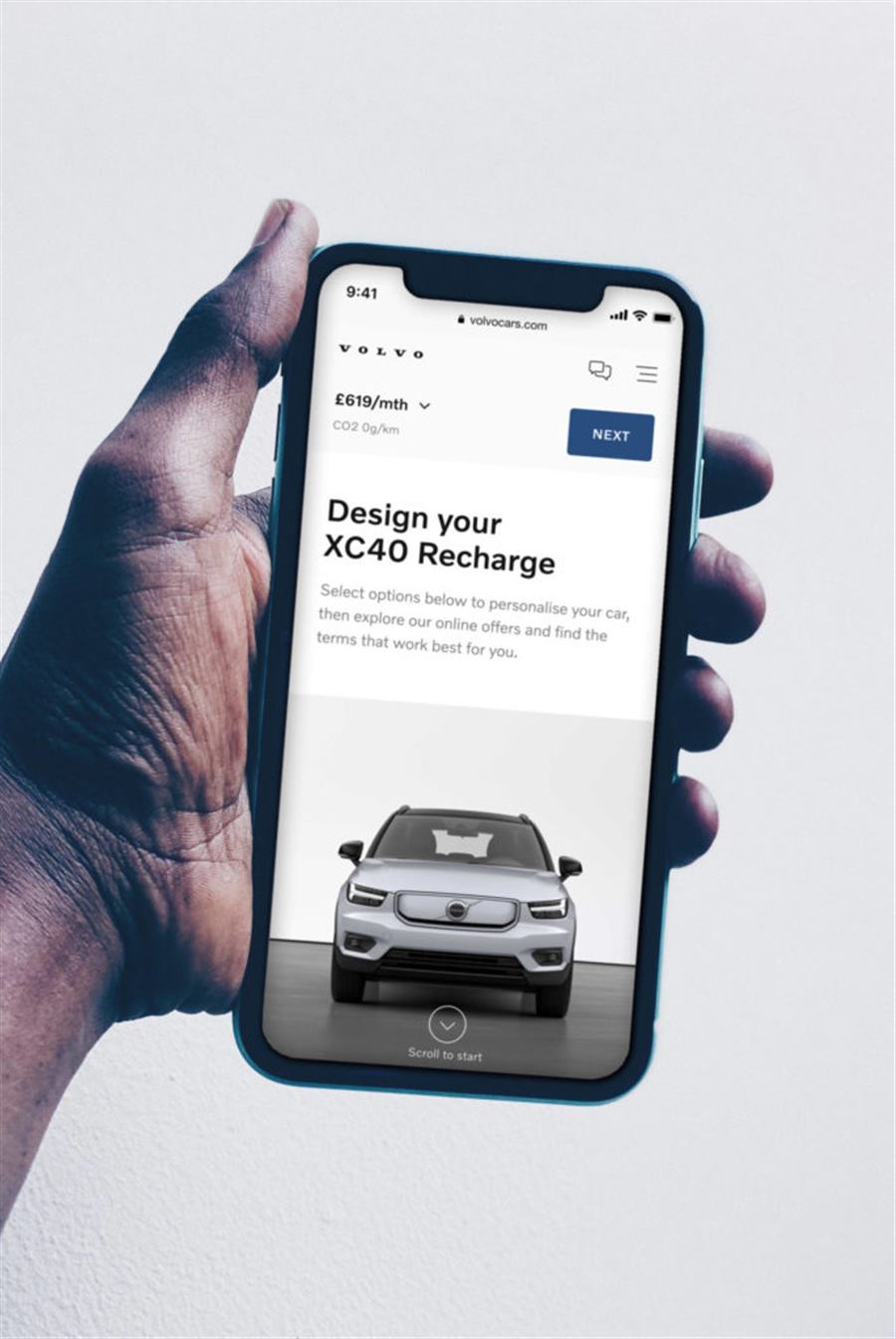
Don't use the Internet and have nowhere to charge your car? Forget Volvo.
Okay, if you don’t use the Internet, you won’t read anything new and you won’t have anything to regret. But Volvo is really turning its business around.
From 2030, every new Volvo will be electric
News has arrived from Sweden that Volvo Cars will be committed to becoming leaders in the fast-growing premium electric car market with a plan to become a fully electric car company by 2030.
Until then, the company will gradually phase out models with internal combustion engines, including hybrids. At Volvo, they expect that legal solutions and the expansion of charging networks will enable this transition to electric cars.
For now, Volvo will only sell its electric vehicles online.
Volvo Cars last year launched its first all-electric car, the XC40 Recharge, in markets around the world. In the coming years, Volvo Cars will introduce several additional electric models. By 2025, the goal is for 50 percent of global sales to consist of fully electric cars, and the rest will be hybrids. By 2030, every car he sells should be fully electric.
And the role of the merchant?
The fight for clients is over - there will be nothing to negotiate here. The buyer buys the car at the price shown on the website, and the seller must prepare it, elegantly hand it over and then service it. In the meantime, they may organize a test drive to help those who are not satisfied by clicking on the page. Volvo emphasizes that the dealer network will be just as important as it is today, but the role of dealers will be limited because electric cars are much simpler. We wonder what interest the owners of car dealerships will have in this approach of the manufacturer? -
VW came up with the name from its e-vehicle: It will be called the Voltswagen
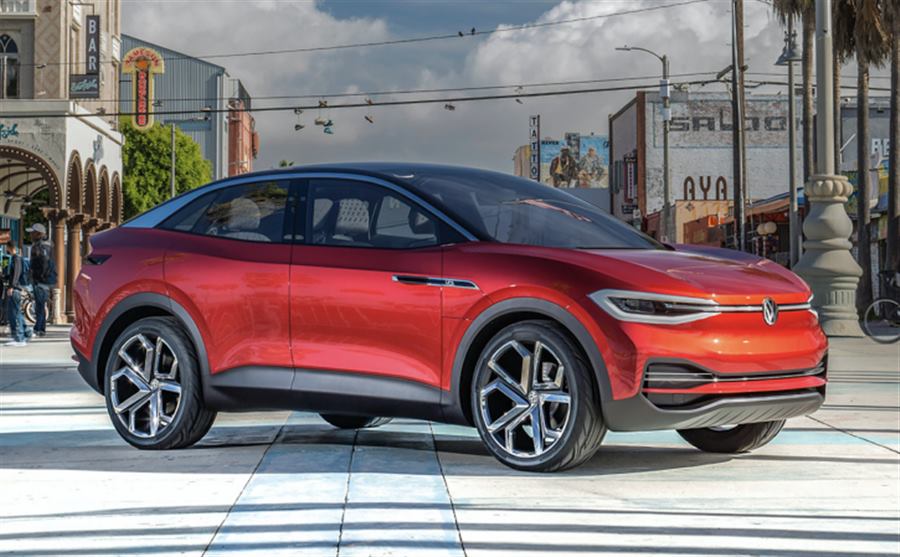
Automotive giant Volkswagen will rename its electric vehicles in the US to ‘Voltswagen’. It has not yet been confirmed whether this will apply to vehicles sold in Europe.
The news allegedly briefly appeared on the American press page yesterday, but was soon removed. Volkswagen's PR, Brendan Bradley, did not comment on the allegations, but according to media reports, a source close to the company said it was a permanent change that would apply to VW in America and would clearly separate electric models from conventional ones.
Although not confirmed, the German brand is not expected to change the name of its e-vehicles in Europe either.
A USA Today reporter quoted part of an official announcement stating that the Voltswagen is more than a name change.
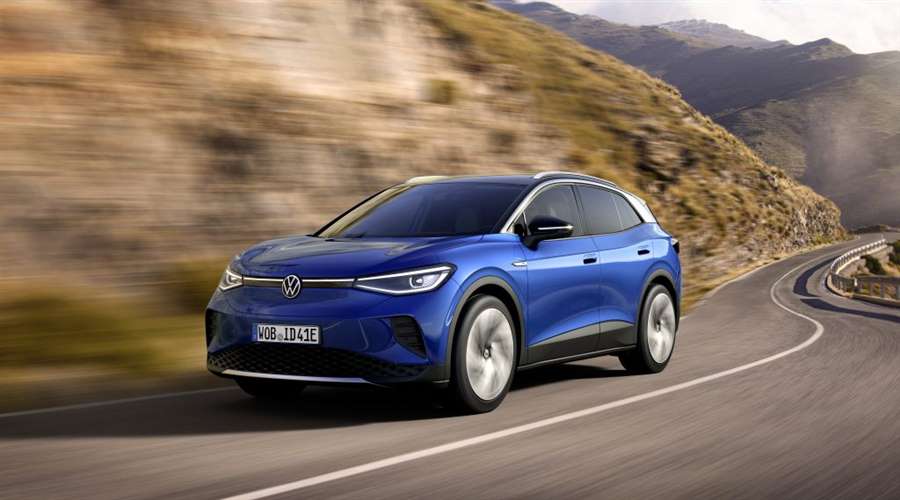
"It is a public declaration by which the company announces future investments in e-mobility," reads the statement.
According to that announcement, electric cars will get the inscription Voltswagen, while the others will keep the classic VW logo.
This news comes at a time when Volkswagen is starting to commercialize the ID.4 electric crossover, the first that could seriously change the power relations in the electric vehicle market in America, Index.hr reports.
Recall, VW has announced 70 electric models by 2029, as well as sales of one million electric cars by 2025.










